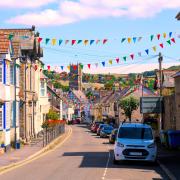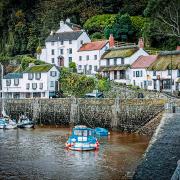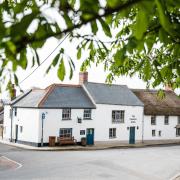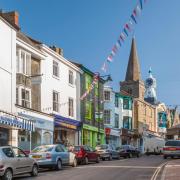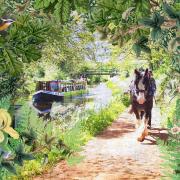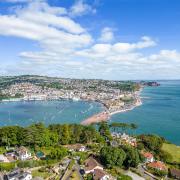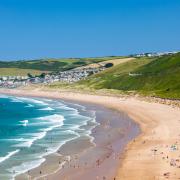Early morning in high summer. The day is just pushing back its duvet. Below me, from this high vantage point above Saunton Sands in North Devon, more than three miles of wave-ridged sandy beach beckons. At this hour, it is mine alone.
Etched by the outgoing tide, the artistry of nature can be fleeting, erased by feet or the next incoming tide. But for the moment the pattern left behind by the waves is beautiful, a fine example, although easily overlooked, of the elements captured in a moment, something to cherish.
Beaches are part of our island culture and offer so much ‘treasure’. For youngsters fortunate enough to have access to the coast, beachcombing is part of childhood’s conditioning, the temptation to seek out washed-up wonders – Poldark’s ‘pickings’. It doesn’t need to be valuable: the coloured jewel of a piece of wave-smoothed sea-glass, a rarer treasure than it used to be due to our modern plastic culture; a lost toy duck amongst a host of scurrying sanderlings; the natural sculptures of sun-bleached driftwood – make whatever it suggests to you, or string bits together for a mobile.

The coast is a sensuous feast. Sun splashes across the open ocean, the ever-changing mood of the sea and play of light across it make those times when the light is sparkling and perfect all the more special. Savour the saltiness of face-caressing wind and listen to the myriad calls of seabirds: evocative curlews, carroty-billed oystercatchers, knobbly-kneed gulls – all with their distinct voices and something to say. The scent of seaweed: delicious and nutritious and endorsed by Jamie Oliver. The tactility of sand-gritty shells.
Wrecks have their own stories to tell and vast numbers of vessels have been lost around our coasts. What secrets lie in the deeps? Some are not so deep. The weathered and decaying wreck at Crow Point diminishes with the years, mere hints of its once-cheer in the fragmented colour on its hull. Once it was cherished; it still is, though differently.
Above and beyond the beach, I tread the coast path, a lengthy regional treasure. It’s a part of our coastal heritage that has its roots in our island’s history of smuggling and those who walked these clifftops to watch out for miscreants.

Sand dunes lurk behind our coasts, a rich wildlife habitat and beloved by botanists. Braunton Burrows, behind Saunton Sands, is abundant with life. In summer the place is saturated with floral colour, for these dunes are home to something in the region of 470 plant species, which astonishment helps to win Braunton the remarkable accolade of England’s most biodiverse parish.
In North Devon a substantial stretch of the coast falls within the National Park where Exmoor meets the sea, tumbling down mighty cliffs to the waves below, beneath a vast expanse of sky. An alluring panorama shaped by aeons of dramatic weather. Relish its grandeur.
Off this coast Devon’s enigmatic isle of Lundy floats out to sea – one of more than 6,000 islands off Britain’s coast. Famed for its puffins, ‘Lundy’ means ‘puffins’ isle’ in Old Norse. On a clear day St Helena’s Church and the Old Light on the highest point of the island may be seen from the mainland, but they are recent history. Lundy’s more tenebrous history tells of human habitation that goes back more than 3,000 years. Wonder at those long-gone lives, that long-ago time.

Devon is unique in England for having two completely separate coasts, each with its distinct character. England’s first natural world heritage site was the Jurassic Coast that runs for 95 miles from Exmouth, on the East Devon coast, to Dorset. It showcases an extraordinary 185 million years of Earth’s geological history. An unimaginable length of time. What ‘treasure’ can possibly depict this? The fossilised part-ichthyosaur that my parents found when I was a child was dated at around 150 million years. That was, and still is, an extraordinary treasure.
Along this coast between Beer and Branscombe nestles the Hooken Undercliff, a sequestered place formed when 10 acres of the cliff slumped towards the sea one night in 1790, resulting in prominent chalk pinnacles and tangled remains of what had been cliff-top fields and hedges. Undeterred, the locals subsequently used the area to cultivate potatoes. Peregrine falcons, the fastest creatures on Earth when they stoop, watch from the pinnacles.
The rounded ‘popples’ of Budleigh Salterton’s beach are protected, so leave them on the beach, but enjoy the astonishing array of soft-hued colours in the ‘grey’. The popples have their origins in the ‘pebblebeds’ of East Devon – layers of pebbles below the heathland, which formed during the Triassic era when the lie of the land and the climate were very different. A mighty river flowed, carrying the stones along, tumbling them into their lovely rounded shapes.

The coast offers gems. Wherever rockpools are found you have small captive worlds beneath the water. Look for the fleshy red jewels of beadlet anemones – to be admired and left alone. Be gentle with all rock-pool creatures, respect the delicacy and balance of their place. Look and leave.
Less extensive but still superbly diverse sand dunes exist along the south coast too, at Dawlish Warren. This nature reserve, with its free-draining sandy soil, is the only place in the whole of England where we find the diminutive botanical treasure that is the sand crocus. Stroll along the nearby sandy beach and keep your eyes peeled for tiny architectural domes – I’ve found many empty sea urchin shells here.
Complete and colourful shells of all shapes and sizes catch the attention, a former someone’s home. Holey stones bring luck and become easier to find once you ‘get your eye in’.

And human-made treats bring joy too. Who can resist the appeal of windblown stripy deckchairs, or a colourful array of beach huts? There’s something quintessentially English about our love of setting up base in these little places, our personal bit of beach territory.
Our coastal pastimes bring pleasure for watchers as well as doers: the wind visibly captured in colourful kites, its power harnessed by red-sailed yachts or wave-skimming windsurfers. Scan the creeks and inlets of the South Hams, so often punctuated by colourful craft, picture-perfect and iconically South Devon.
Galloping a horse along the beach may not be for everyone, but those of us who have will appreciate the elemental exhilaration of speed along the shore. I once watched a horse and rider practising dressage at Sandy Bay, equine ballet with a backdrop of the sea. Free theatre.

Not everywhere allows horses or dogs in the summer, but when you can, take a moment to appreciate canine joy on the beach, their unbridled enthusiasm brightens the dullest day – I’ve never seen a fight break out.
The day wanes. A bright sun path beckons across the spangled sea to the distant horizon, tempting and untreadable. Waves lap the shore with that evocative, ceaseless sound that reminds us of the never-ending cycle of the tides.... the passage of time.... our moon’s orbit…. Earth revolving in space....
Night claims the shoreline, giving pause to ponder treasured moments from the day now closing down, until light, tide and time return tomorrow.




